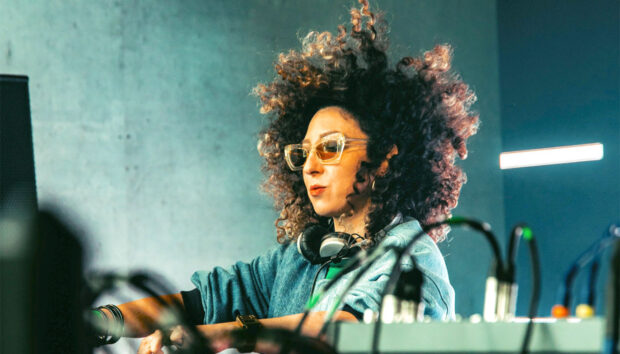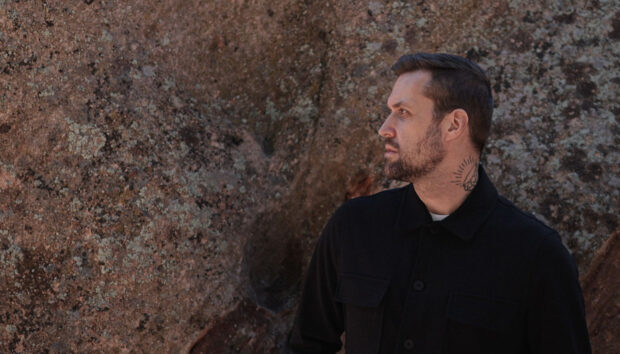Arcelious Harris, better known as Swagg R’Celious, is a GRAMMY-winning producer, vocalist, songwriter, and lecturer from Manchester, Georgia. Adept at blending and transitioning between multiple genres, he’s racked up credits for a diverse roster of artists including Babyface, Wale, Alicia Keys, Dawn Richard, and K-pop star Hyo Lee – but it’s his long-standing writing and production partnership with R&B artist H.E.R. that’s seen him thrust into the spotlight most recently. H.E.R.’s eponymous 2019 album picked up a GRAMMY for Best R&B Album and nominations in four other categories, including Best Album.
For Patch and Play – our series of original MASSIVE X artist presets – Swagg has turned in a floor-rattling bass patch that proves that less can be more when it comes to bass frequencies. The signal starts with a single sawtooth wave from Oscillator 2, which has its high end rounded off by the Asimov filter in low-pass mode. The filter’s built in drive control adds back in a touch of grit and saturation to help things cut through the mix. From there, there’s some slight movement courtesy of the flanger, a subtle sense of space from the Dimension Expander, and some final tonal sculpting with the master EQ. From this solid foundation, you have a handful of thoughtfully chosen macro controls that can be used to help the patch fit into your own productions, or for some subtle performative tweaking.
We spoke to Swagg from his current base in NYC to gain some insight into his creative process and how he put together his patch. You can hear it in action below, then download it here to play, tweak, and put it to use in your own productions.
Can you tell us about the inspiration behind the MASSIVE X patch you made for us?
I’ve always been fascinated with 808’s and bass in general – with trying to push the ‘low-end’ experience. It’s become a very integral part of my production sound, to the point where some of my close friends jokingly call me, ‘The Ambassador of Low-end.’ So I wanted to create something that represents my love for bass and also pays tribute to Robert Moog. I wanted to design a patch that had enough character sonically that would not only translate on records, but also fill up an arena.
Going from MASSIVE to MASSIVE X, there’s quite a lot of extra depth to wrap your head around. Are you someone who finds complex user interfaces intimidating, or are you rather inspired by the options?
I think initial intimidation by the “idea” of deeper synths is a possibility, but once embraced and explored, it’s not only fun, but creatively liberating. I’m definitely inspired by the interface. For me, it’s smooth looking and intuitive. Also, I love the fact there are theme options.
Before getting started with MASSIVE X, were you familiar with the original?
My first experience with Massive 1 was in 2010. I was greatly intrigued and impressed by the presets and the sound designing possibilities.
Do you work with preset sounds? How do they typically influence the music you make?
I love presets. Sometimes, my ideas come faster than I can get them down, so presets help me facilitate those ideas, and in a lot of cases, spark new ones.
So are you more of a traditional player, or rather a tech-savvy, knob-tweaking musician?
I am uniquely balanced between a traditional player and a technologist. I grew up in a musical home where everybody played something, which influenced me as a traditional player. However, I have a degree in music technology which has developed a love for technology, and I enjoy exploring and discovering sounds. Through technology, I am able to innovate and push the envelope.
Your biggest credit to date is collaborating with H.E.R. which won you a GRAMMY. Would you say there was a lot of traditional songcraft involved in that collaboration, or did the sounds inspire the songs?
Both basic songwriting and sound-inspired song. Sometimes, a sound sparked the writing idea, then we moved to a more ‘traditional’ way of writing. For me, new sounds are always a source of inspiration.
What’s your take on that distinction – between being a ‘pure’ musician and letting sound lead the way?
I value both perspectives. However, music and music making have always reflected the technology and instruments of its time. The more access we have, the more options we have to express an idea. The very foundation of music theory was built on technology and sound.
Honestly, in my sessions it’s all of the above. In most cases it’s the right patch and preset combined with the right chords or melodies. You can play the same chords on with a patch that’s a little more exciting and sonically stimulating, and you have a totally new appreciation for the chords that you may have played a hundred times. As a creator, new patches always excite me because I get to stretch my imagination and capture ideas that might not have ever been birthed without the nudge of interesting new sounds.
Your brother is also a musician – and the Musical Director for the H.E.R. tour. Do the two of you trade patches that were used in the studio?
Absolutely! Sometimes he calls me in to help program for shows as well. Sound design is important to the live experience. It helps translate studio recordings to a live, stage presentation with the same sound the ears of the listening audience are trained to expect.
















